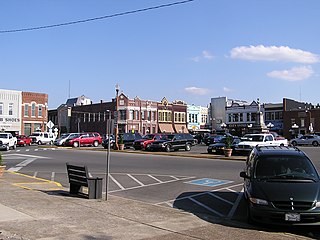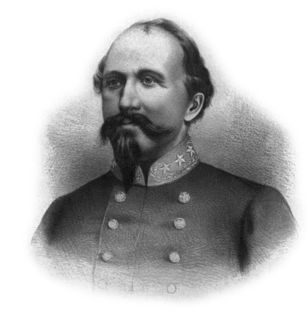
John Hunt Morgan was a Confederate general in the American Civil War.

Richard Montgomery Gano was a physician, Protestant minister, and brigadier general in the army of the Confederate States during the American Civil War.

The Battle of Hartsville was fought on December 7, 1862, in northern Tennessee at the opening of the Stones River Campaign the American Civil War. Hartsville Battlefield is listed on the National Register of Historic Places.
The First Battle of Murfreesboro was fought on July 13, 1862, in Rutherford County, Tennessee, as part of the American Civil War. Troops under Confederate cavalry commander Brig. Gen. Nathan Bedford Forrest surprised and quickly overran a Federal hospital, the camps of several small Union units, and the jail and courthouse in Murfreesboro, Tennessee. All of the Union units surrendered to Forrest, and the Confederates destroyed much of the Union's supplies and destroyed railroad track in the area. The primary consequence of the raid was the diversion of Union forces from a drive on Chattanooga.
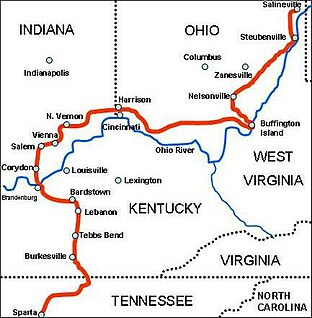
Morgan's Raid was a diversionary incursion by Confederate cavalry into the northern U.S. states of Indiana and Ohio during the American Civil War. The raid took place from June 11–July 26, 1863, and is named for the commander of the Confederates, Brig. Gen. John Hunt Morgan. Although it caused temporary alarm in the North, the raid was ultimately classed as a failure.
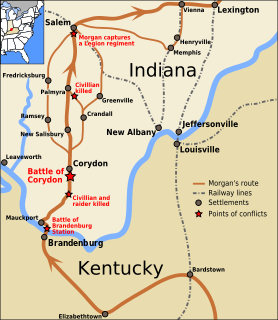
The Battle of Corydon was a minor engagement that took place July 9, 1863, just south of Corydon, which had been the original capital of Indiana until 1825, and was the county seat of Harrison County. The attack occurred during Morgan's Raid in the American Civil War as a force of 2,500 cavalry invaded the North in support of the Tullahoma Campaign. It was the only pitched battle of the Civil War that occurred in Indiana, and no battle has occurred within Indiana since.
The Battle of Salineville occurred July 26, 1863, near Salineville, Ohio during Morgan's Raid in the American Civil War. Except for the St. Albans (Vermont) Raid, it was the northernmost military action involving the Confederate States Army. The Union victory shattered John Hunt Morgan's remaining Confederate cavalry and led to his capture later that day.
The 9th Pennsylvania Cavalry Regiment was a Union Army cavalry regiment that participated in the American Civil War. It was one of the most respected Union volunteer cavalry units in the war.
The Battle of Buffington Island, also known as the St. Georges Creek Skirmish, was an American Civil War engagement in Meigs County, Ohio, and Jackson County, West Virginia, on July 19, 1863, during Morgan's Raid. The largest battle in Ohio during the war, Buffington Island contributed to the capture of the famed Confederate cavalry raider, Brig. Gen. John Hunt Morgan, who was seeking to escape Union army pursuers across the Ohio River at a ford opposite Buffington Island.
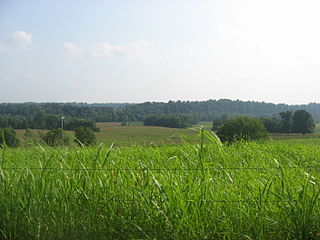
The Battle of Tebbs' Bend was fought on July 4, 1863, near the Green River in Taylor County, Kentucky during Morgan's Raid in the American Civil War. Despite being badly outnumbered, elements of the Union army thwarted repeated attacks by Confederate Brig. Gen. John Hunt Morgan's dismounted cavalry.

Kentucky was a border state of key importance in the American Civil War. President Abraham Lincoln recognized the importance of the Commonwealth when, in a September 1861 letter to Orville Browning, he wrote:
I think to lose Kentucky is nearly the same as to lose the whole game. Kentucky gone, we cannot hold Missouri, nor Maryland. These all against us, and the job on our hands is too large for us. We would as well consent to separation at once, including the surrender of this capitol.

The Confederate Heartland Offensive, also known as the Kentucky Campaign, was an American Civil War campaign conducted by the Confederate States Army in Tennessee and Kentucky where Generals Braxton Bragg and Edmund Kirby Smith tried to draw neutral Kentucky into the Confederacy by outflanking Union troops under Major General Don Carlos Buell. Though they scored some successes, notably a tactical win at Perryville, they soon retreated, leaving Kentucky primarily under Union control for the rest of the war.

The 11th Michigan Volunteer Infantry, initially known as Colonel May’s Independent Regiment, was a unit in the Union army during the American Civil War. The regiment fought with the Army of the Cumberland in numerous battles, including Stones River, Chickamauga, and Missionary Ridge.

The Second Battle of Cynthiana included three separate engagements during the American Civil War that were fought on June 11 and 12, 1864, in Harrison County, Kentucky, in and near the town of Cynthiana. This was part of Confederate Brigadier General John H. Morgan's 1864 Raid into Kentucky. The battle ultimately resulted in a victory by Union forces over the raiders and ended Morgan's Last Kentucky Raid in defeat. Morgan's command had previously captured the town in the First Battle of Cynthiana, July 17, 1862.

The Confederate Monument in Glasgow, Kentucky, built in 1905 by the Kentucky Women's Monumental Association and former Confederate soldier John A. Murray, commemorates those who gave their lives in service for the Confederate States of America. It is located on the side of Glasgow's courthouse. The Confederate soldier, made of bronze, is at parade rest, and features details such as a bedroll, canteen, kepi hat, and rifle. It stands on a limestone pedestal.

Lexington, Kentucky was a city of importance during the American Civil War, with notable residents participating on both sides of the conflict. These included John C. Breckinridge, Confederate generals John Hunt Morgan and Basil W. Duke, and the Todd family, who mostly served the Confederacy although one, Mary Todd Lincoln, was the first lady of the United States, wife of President Abraham Lincoln.

James Murrell Shackelford was a lawyer, judge, and general in the Union Army during the American Civil War. He has the distinction of having captured Confederate cavalry commander John Hunt Morgan in mid-1863, effectively ending "Morgan's Raid".
The Battle of Augusta was a battle during the American Civil War that took place on September 27, 1862, in Augusta, Kentucky, between the Bracken County Home Guard (Union) and the Confederate 2nd Kentucky Cavalry Regiment under command of Colonel Basil W. Duke, a brother-in-law of John Hunt Morgan. The skirmish resulted in a victory for the Confederacy but the number of Confederate casualties and lack of ammunition for his artillery caused Confederate Colonel Duke to abandon plans to cross over the Ohio River into the northern states. This occurred after twenty buildings in town were destroyed by deliberately set fires.
